
View of the archaeological excavations at the Mansion Pottery site. (Photo, Jonathan Glenn.)
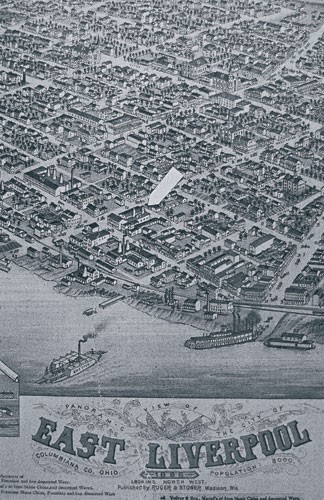
East Liverpool, Ohio. Lithograph, Albert Ruger and J. J. Stoner, 1886. Arrow indicates city block on which the Mansion Pottery site was located. (Courtesy, East Liverpool Museum of Ceramics.)

Photograph of East Liverpool, Ohio. Undated. (Courtesy, East Liverpool Museum of Ceramics.)

1887 Sanborn Fire Insurance Company Map superimposed on a drawing of the Mansion Pottery excavation site. (Drawing, Thomas G. Whitley and Jonathan Glenn.)
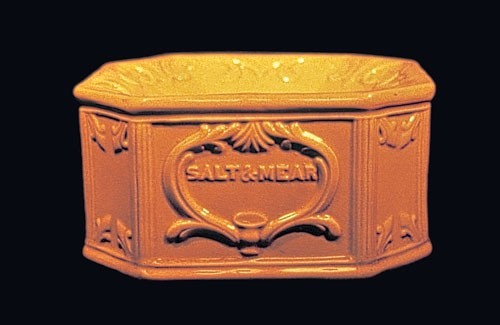
Spittoon, James Salt and Frederick Mear, East Liverpool, 1842–1853. Yellow ware. H. 8 1/4". One of the few whole vessels attributable to the Salt and Mear ownership of the Mansion Pottery. (Courtesy, East Liverpool Museum of Ceramics and William C. Gates Jr.)
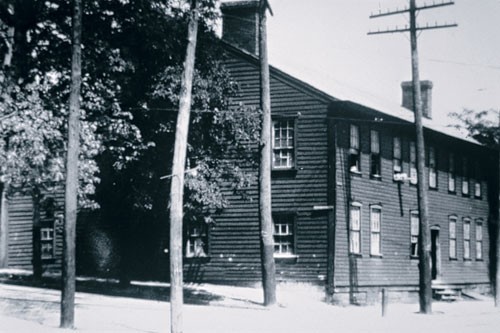
Mansion House Hotel building, undated photograph. Note the mold board, with several pots on it, that extends from a second-story window. (Courtesy, East Liverpool Museum of Ceramics.)
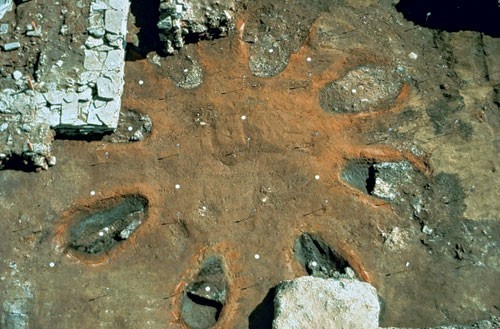
Overhead view of the first kiln, illustrated in fig. 1, showing the fireboxes. (Photo, Jonathan Glenn.)
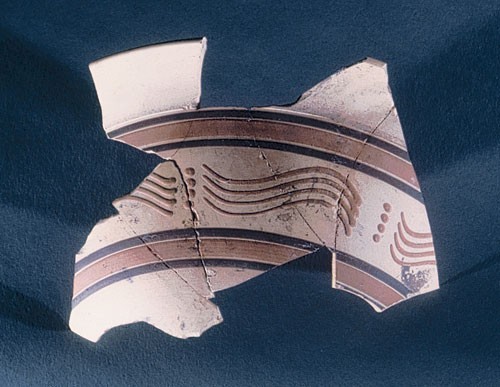
Chamber pot fragments, Mansion Pottery, East Liverpool, Ohio, 1842–1860s. Bisque yellow ware. Decorated with dark brown and pumpkin bands, and slip-trailed pumpkin lines. (Photo, Melinda McNaugher.)

Teapot and jug fragments, Mansion Pottery, East Liverpool, Ohio, 1851–1860s. Rockingham-glazed yellow ware. These relief-molded vessels illustrate the Minister/Apostle motif (at left) and the “Rebekah at the Well” motif (at right). (Photo, Melinda McNaugher.)
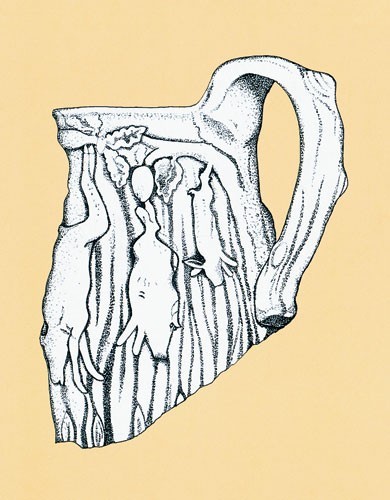
Drawing of a Rockingham-glazed yellow ware pitcher fragment with hanging game motif. (Drawing, Martin T. Fuess.)
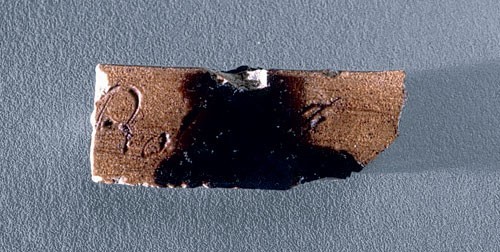
Yellow ware stilt with the name “Robert” inscribed into the clay while the clay was wet. The name is partially obscured by Rockingham glaze drips. (Photo, Melinda McNaugher.)

Hollow ware fragments, Mansion Pottery, East Liverpool, Ohio, 1842–1860s. Bisque yellow ware. Decorated with dark brown and pumpkin bands, pumpkin slip trails, and cat’s-eye motif showing slip imperfections. (Photo, Melinda McNaugher.)
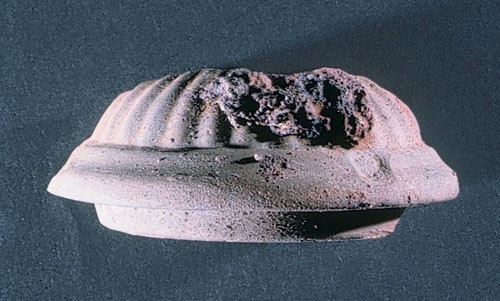
Teapot lid, Mansion Pottery, East Liverpool, Ohio, 1842–1912. Bisque yellow ware. (Photo, Melinda McNaugher.)

Colorless glazed yellow ware vessel fragments showing glaze imperfections. (Photo, Melinda McNaugher.)

View showing the fireboxes of the second kiln. (Photo, Jonathan Glenn.)
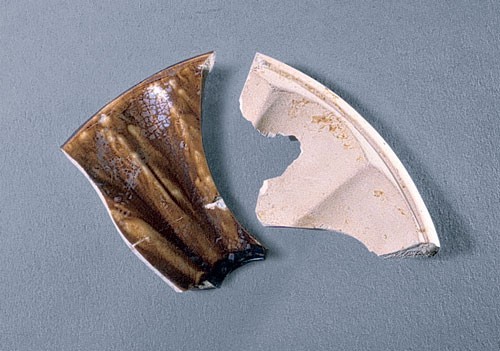
Spittoon fragments, Mansion Pottery, East Liverpool, Ohio, 1842–1860s. Yellow ware. An example of Rockingham glaze (left); an example of bisque (right). (Photo, Melinda McNaugher.)
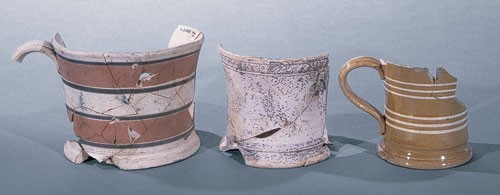
Mugs, Mansion Pottery, East Liverpool, Ohio. Yellow ware, 1842–1860s. An example of bisque with slip bands (left); bisque with relief molding (center); slip-banded with colorless glaze (right). (Photo, Melinda McNaugher.)

Bowl, Mansion Pottery, East Liverpool, Ohio, 1842–1860s. Partially reconstructed London-shape bowl with dark brown and pumpkin bands and slip-trailed pumpkin lines. (Photo, Melinda McNaugher.)
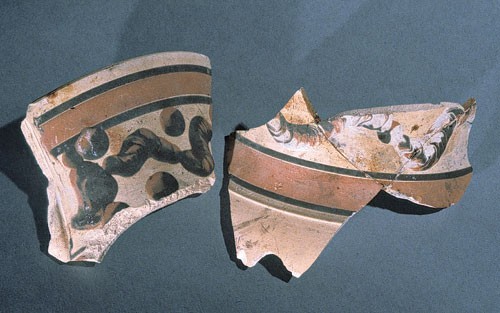
Bowl and jug fragments, Mansion Pottery, East Liverpool, Ohio, 1842–1860s. Yellow ware bisque vessels with bands, cat’s-eye, and earthworm slip motifs showing slip imperfections. (Photo, Melinda McNaugher.)

Yellow ware kiln furniture, including stilts and spurs. (Photo, Melinda McNaugher.)
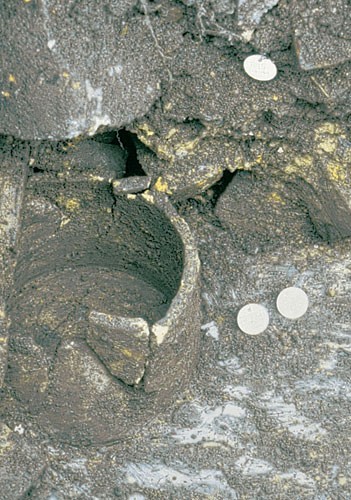
Photograph of a sagger in fill of biscuit warehouse. (Photo, Barbara Gundy.)
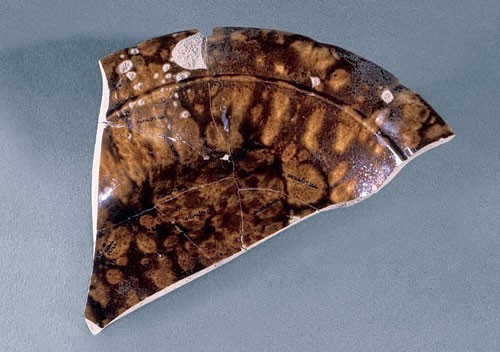
Baker fragment, Mansion Pottery, East Liverpool, Ohio, 1842–1912. Yellow ware with Rockingham glaze. (Photo, Melinda McNaugher.)

Bottle stoppers, Mansion Pottery, East Liverpool, Ohio, 1842–1853. Yellow ware with Rockingham glaze. (Photo, Melinda McNaugher.)
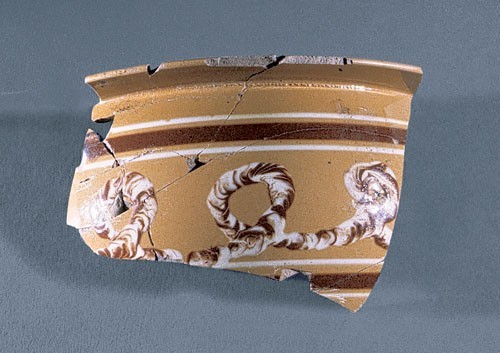
Chamber pot fragment, Mansion Pottery, East Liverpool, Ohio, 1842–1912. Colorless glazed chamber pot fragment with reddish brown and white slip bands, with common cable or earthworm motifs. (Photo, Melinda McNaugher.)
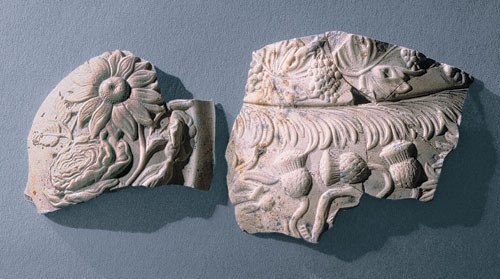
Molded jug fragments, Mansion Pottery, East Liverpool, Ohio, 1842–1912. Yellow ware bisque relief-molded jug fragments, with an example of a floral motif (left) and a thistle motif (right). (Photo, Melinda McNaugher.)

Yellow ware bisque sherds. Mansion Pottery, East Liverpool, Ohio, 1842–1912. An example of relief molding and dark brown and pumpkin slip bands (top left), a baker with relief-molded beading (top right), lathe-turned bands (bottom left), and dark brown and pumpkin bands with pumpkin slip-trailed lines and dots (bottom right). (Photo, Melinda McNaugher.)
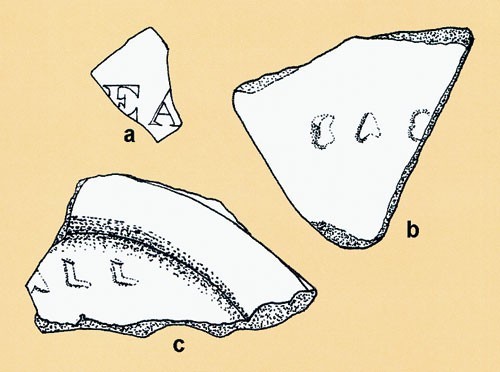
Illustration of three partial maker’s marks found on ceramic sherds at the archaeological excavation of the Mansion Pottery. (a) “. . . EA . . .” from the Salt and Mear operation; (b) an unidentifiable mark; and (c) “. . . ALL . . .” from the Croxall operation. (Drawing, Martin T. Fuess)
